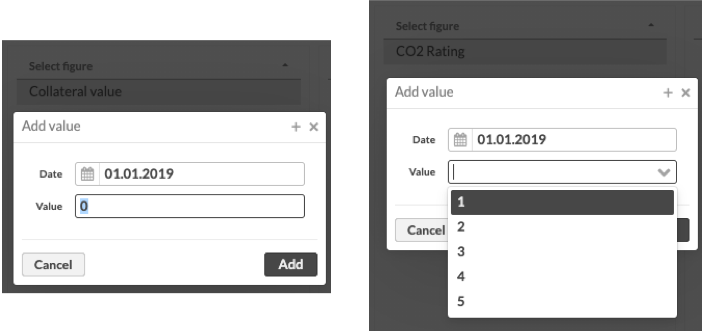Configuring key figures in Preferences
Key figures Preferences allow you to configure the available key figures. You can flexibly decide which types the key figure is available for and what kind of values users can enter. For example, you can link a key figure to certain portfolio or security type, and allow users to select values from a dropdown instead of entering them manually.
 |
Key figure definitions
You can either select an existing key figure definition from the left, or Add new key figure. Hard-coded security key figure and portfolio key figure definitions are also available for you to view but not modify. Key figures are defined through the following fields:
Select where you want to use this key figure - select whether you want to associate the key figure with "Contact", "Portfolios" or "Securities". The key figure will be available in the corresponding window for the corresponding type. You cannot configure a key figure that would be available to contacts and portfolios at the same time.
Define the types you want this key figure to be available for - if you want to, you can further restrict the key figure to only be available to certain types, for example to "customers" but not other types of contacts or "bonds" and "funds" but not other types of securities. Define the types as comma-separated list of type codes (e.g. BOND,FUND). If you don't restrict the visibility of they key figure with types, key figure will be available to all contacts, portfolios or securities, respectively.
Code - define a unique code for your key figure. Use only alphanumeric values (i.e. letters a-z and numbers 0-9, no spaces or special characters). Key figure code is used to identify the key figure programmatically, and you cannot modify it after you save your key figure.
Name - define a name for your key figure. Key figure name is used to show the figure throughout the application.
Value type - select what kind of values users can enter to this key figure (e.g. whether your users can enter a number or text as the key figure value). By default, key figure values are expected to be numbers (integer) - you can select the value type from integer (whole number), string (text), double (number) or boolean (true / false options).
Allow users to enter values manually or select from a pre-defined list - select whether you want your users to enter values manually (e.g. enter numbers or text freely, depending on the value type), or whether you want to provide a dropdown list of options the user can choose from. See Enter values manually or select from a pre-defined list for more details.
Define the values users can select - if you selected "Select values from a predefined list" above, you define the values your users can choose from. Define the available values or value-text pairs each on their own row. If you leave the list empty, your users cannot select a value for they key figure. See Enter values manually or select from a pre-defined list for more details.
Enter values manually or select from a pre-defined list
The last selection in the key figure definition allows you to control how your users can put in the key figure values: select whether you want your users to enter values manually (e.g. enter numbers or text freely, depending on the value type), or whether you want to provide a dropdown list of options the user can choose from.

If you want your users to enter values manually, when adding a value, your user is presented with an input field for a number or text (depending on the key figure's value type). The user can enter the value manually into the field.
If you want your users to select values from a pre-defined list, when adding a value, your user is presented with a dropdown where your user can select the value. When defining the values, you have two options:
Option | Example | Purpose |
|---|---|---|
Value | 1 2 3 | Allows your users to select directly from a list of values. Your values can be either number or text, and the selection the user makes is stored directly. |
Value-text pair | 1=Poor 2=OK 3=Good | Allows you to associate a text with a numeric value - your users select from options ranging from "Poor" to "Good", while in the background you get a numeric rating. This allows you to for example calculate averages based on the values the user selects, while showing the user with a descriptive text. |
Modifying key figure definitions
You can change the key figure preferences (except for the key figure code) after you have first defined a key figure - you can for example change the key figure name afterwards.
However, if you change the key figure definition in Key figure Preferences, and you have already added key figure values on your contacts, portfolios or securities, the values you have stored are still available but you might not be able to modify them any more. This might happen if you change a key figure from "contact" to "portfolio" (you cannot any more modify values stored on contact), or if you change the type from "string" to "double" (you cannot any more modify text values when numbers are expected).